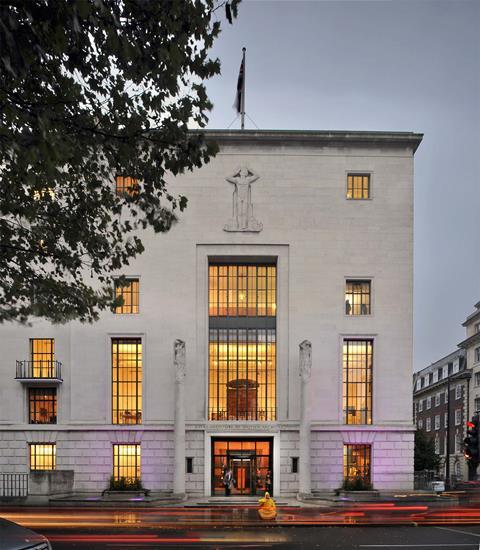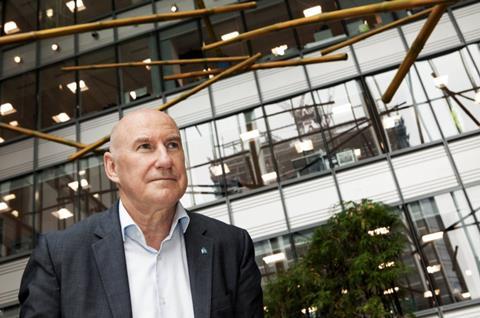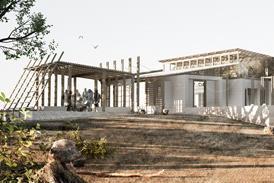Jack Pringle has been a driving force at the RIBA for decades – from council member in his twenties to president in 2005, and now chair of the board. He spoke to Ben Flatman about steering the institute through crisis and into an ambitious era

Jack Pringle has spent much of his career closely connected to the Royal Institute of British Architects. His involvement began early, when he was elected to the council in his twenties. A second spell came with his presidency between 2005 and 2007. He returned again in 2020, at what he describes as “a moment of necessity,” and is now three years into his second term as chair of the RIBA board.
“We were losing quite a lot of money, so I had to stabilise the budget, which we did,” he recalls of that return. “Of course that meant downsizing the staff, which is never easy or popular.”
But the financial crisis was only one part of the picture. “I was acutely aware that the position of the architect in the construction industry is not what it should be,” he says.
The wider climate felt equally fraught. “Externally there was also a huge amount going on, not least Grenfell, sustainability, remuneration, Brexit. We had been in a long recession, which is always really wounding to architects.”
For Pringle, the immediate task was restoring stability and a clearer sense of institutional purpose. “To get good architecture you have to have good architects,” he says. “That’s how the daisy chain works.”
With finances now stabilised, the 2020 governance reforms established, and the Building Safety Act reshaping professional responsibilities, Pringle argues that the RIBA has an opportunity to reassert its relevance. His current term is shaped by an effort to rebuild confidence in the profession’s institutions and its standing in public life.
Beginnings
Pringle grew up a long way from the culture of architectural practice. Born in Glasgow and raised in the Midlands, he describes a childhood shaped by heavy industry.
“I come from an engineering family,” he says. “It was a very industrial background. I wanted to be an architect, not really knowing what an architect did, but I thought it looked really interesting.”
Architecture school in Bristol gave him his first exposure to the discipline, but it was Powell & Moya which gave him his first real education. Fresh from winning the professor’s prize at Bristol, he joined the practice as a young assistant and quickly found himself working almost exclusively for Sir Philip Powell.
I worked for Sir Philip Powell for eight years as his gopher. If he wanted a sandwich, I got him a sandwich
“I worked for Sir Philip Powell for eight years as his gopher. If he wanted a sandwich, I got him a sandwich. If he wanted a building drawn up, I drew him a building,” he recalls.
The apprenticeship-style relationship clearly stayed with him. Powell was knighted during Pringle’s time there, the practice won the Royal Gold Medal, and Pringle absorbed an approach to design which shaped his view of the profession. “It was a very formative time. I think he taught me how to think.”
His introduction to the RIBA came just as early. “As a really young architect, probably not even qualified, I built their exhibition at the RIBA,” he says. That exposure led him quickly into the organisation’s internal politics. By 29 he was on the council and active in advocating for better pay and working conditions.
“I started my tour of duty in the salaried architects group, arguing about pretty much the same things that the younger people are arguing about now.”
A life in practice
At 29, Pringle left Powell & Moya to establish a practice that would become Pringle Brandon. “Initially we did all sorts of general purpose architectural things, and then, after the big recession in 1990 when there was no other work, we won some very significant commercial fitting out projects.”
The practice found its footing in high-value commercial interiors. “We were doing £200m commercial fit-outs,” he recalls. “We did headquarters for JP Morgan, Morgan Stanley, Bank of America, Linklaters, Slaughter and May, Allen & Overy. Tens of millions of square feet.”
The model was hybrid. “We developed a practice at that time which was a cross between management consultancy and interior architecture,” he says. That approach supported later moves into hotels, residential towers and work in the Middle East.
After almost three decades of growth, Pringle sold the company to Perkins & Will and became the firm’s regional director for Europe and the Middle East, overseeing offices in London, Paris, Copenhagen, Dubai and Shanghai. “There was a fairly big train set,” he says dryly.

By 2020, he wanted a different pace. “I didn’t really want to do that forever,” he says. “So, during covid, I took the opportunity of bailing out, and I started yet another practice, this time with my eldest daughters, Maxine and Frankie.”
Studio Pringle marks a deliberate shift back to a smaller, more personal scale. “I’m spending time trying to build this family practice up,” he says, “as well as working for the RIBA.”
Presidency
Pringle’s first term in RIBA’s senior leadership came in 2005, when he was elected president. His motivation was clear: “I stood for president because I was really concerned about public procurement via PFI. I thought it was really shoddy and very bad value for money, which indeed it was. I got elected and spent a lot of time lobbying the government.”
With PFI embedded across public-sector construction, he saw that isolated advocacy by RIBA would achieve little. “The government would not listen to architects alone,” he says.
His response was to widen the tent. “We had a seminar. We invited surveyors, engineers, financiers, clients. We got a broad church of people together to debate the issue.”
You can’t just rock up with a great idea and expect it to go through. You have to form a coalition of the willing
The coalition gave the profession a stronger platform. “We agreed an outcome and we could then take that to the government,” he says. “The government would then say, ‘OK, you’ve got broad agreement across not only the professionals but the construction industry and the client bodies. Now we will listen to you’.”
It was a lesson in how to exert influence effectively. “You have to take people with you,” he says. “You can’t just rock up with a great idea and expect it to go through. You have to form a coalition of the willing.”
But the presidency also taught him its limits. “You can’t do anything in two years,” he says. He credits the continuity provided by his successor, Sunand Prasad: “We pretty much worked hand in glove for that entire time. There was a policy span that went over four years, which made it effective.”
Becoming board chair
When Pringle returned as an elected council member in 2020, the RIBA was in the middle of a financial storm, with the organisation downsizing and restructuring. The governance framework had also shifted.
“When I was president back 20 years ago, I was chair of council and chair of the trustees, because council were the trustees,” he explains. “I was only too aware that the Charity Commission thought that was a dysfunctional arrangement because you can’t really have 45 directors in a company, it’s nuts.”
In April 2020, RIBA established a new board of trustees, separating governance from representation. “For good governance, there had to be a smaller controlling board, and that’s what was put in place,” he says. The council became advisory and the board assumed fiduciary responsibility.

When he became chair in January 2021, he found a board of 12, including “a minority, but a really helpful minority of non architects, really specialist people from the world of finance or culture or management”. Together, he says, they “set to… straightening out the RIBA”.
The finances, he argues, have since been transformed. “We were fortunate to have a terrific balance sheet because you will recall we sold NBS for £170m,” he says. “NBS was giving us £4.5m a year profit. By most yardsticks it would have been worth less than £90m and we sold it for £170m. OK, so this has put us in an amazing position.”
He also oversaw a reduced London footprint, including the decision to relinquish 76 Portland Place and consolidate activity at the main headquarters.
Pringle describes the current capital programme, including the refurbishment of 66 Portland Place and plans for a new museum of architecture, as “the most ambitious programme we have done since the 1950s.” The cost, he acknowledges, is substantial.
“It’s quite expensive. It is ambitious,” he says, but insists it is necessary. “What is unavoidable is refurbishing 66 because all the systems are past its end of life.”
Looking ahead, he sets out the scale of the ambition. He speaks of delivering “an amazing new platform for the RIBA” and “an amazing new museum of architecture in the heart of London”, one which will create “a huge focus on architecture and a terrific facility for our members”.
RIBA’s purpose
Ask Pringle what the RIBA is for and he reaches immediately for the charter. “If you look at the charter,” he says, “the RIBA is a cultural organisation for the promotion of the arts and sciences of architecture through to cities and also education.” He is clear about what it is not: “It absolutely does not present the RIBA as a self-serving membership organisation and almost trade union. If it did, I wouldn’t be here.”
He argues that supporting architects remains fundamental to that wider cultural purpose. “To support architecture we have to support the education of architects,” he says. “We have to support our members in practice.”

He is also clear about which members most rely on the RIBA’s infrastructure. “This is mainly medium to small practices,” he says. “The really big battalions have got all the money and resources they need to perform the insurance, HR functions, the contract functions. But we provide all of that support for all the medium and small practices.”
Communication with members, he concedes, has not always been strong enough. “Our communications could be more direct, possibly more heartfelt,” he says. “Sometimes they’re a little bit too corporate because we’re very well advised, but sometimes we need to be just a little bit more. I’m an architect talking to my fellow architects.”
Engagement remains an issue. “It’s bad, but it’s not as bad as it seems,” he says of recent election turnouts. “Of our 50,000 members, almost half are students that don’t vote. So the practising architects’ percentage voting is probably double what it actually seems to be. It’s still not great.”
His standard answer to those who question what the RIBA actually does is consistent. “People often say, what does the RIBA do?” he says. “And I pull them straight to the Monty Python line, what have the Romans ever done for us? I have a huge litany of things the RIBA is constantly doing, and eventually they just say, ‘OK, I give up’.”
For Pringle, the case for RIBA remains self-evident. “If the RIBA didn’t exist,” he says, “you’d have to invent it tomorrow to do all the things that need doing.”
The chair–president dynamic
Under the reformed constitution, leadership is split between the chair, who provides continuity, and the president, who acts as the public voice. “The great thing about a president coming in every two years is they bring in a fresh mandate,” says Pringle. “Focused ideas about what they think are the current issues of the day.”
The board, by contrast, offers “long form continuity”, with his own term running nearly five years and trustees serving six. “That gives the ability to study issues and build campaigns advised by council.”
The presidency is a sprint. It’s under two years. The board provides the stable policy platform
Pringle accepts the structure can look untidy, but argues it functions well. “The presidency is a sprint,” he says. “It’s under two years. The board provides the stable policy platform.”

He has worked with three presidents – Simon Allford, Muyiwa Oki and now Chris Williamson – each with different priorities. “Simon was great, Muyiwa was great, and Chris I think is going to be great,” he says. “Each brings something slightly different to the table.”
He is particularly aligned with Oki’s focus on pay and working conditions. “When Muyiwa came to the table, I completely agreed with him on a lot of these issues,” he says. “I started my tour of duty in the salaried architect group arguing about pretty much the same things.”
The biannual rotation at the top of the institute, he argues, is a strength rather than a weakness. “The membership likes the democratic mandate that an incoming president has,” he says. “It brings vitality to the organisation.”
The system, he suggests, “actually works quite neatly” so long as the chair and president pull in the same direction.
Education reform and the ARB relationship
Pringle has strong views on education reform and on what he sees as the slow pace of change coming at the Architects Registration Board (ARB). He sees the seven-year route to qualification as no longer defensible. “It takes 10 years on average for architects to get qualified – it’s insane,” he says.
“You can qualify as a barrister and have people’s liberty in your hands, and we have young people taking 10 years to qualify. It’s not good for them, it doesn’t do the status any good, and it’s bad for diversity.”
He welcomes the ARB’s move towards competency-based assessment but calls the process “unnecessarily protracted […] They said they moved to an outcomes-oriented assessment,” he says. “Well, hello – the RIBA has been doing outcomes-oriented assessments for decades.”
He also argues that the ARB and RIBA should simplify the system by aligning their criteria. “We’ve been saying, for the sake of the schools, we need to unify these,” he says. “They’ve been reluctant to this date, but I live in hope we will be able to do that.”
Post-Grenfell reform and the principal designer opportunity
Post-Grenfell, the Building Safety Act has reshaped professional responsibilities, and Pringle sees the new principal designer role as a chance for architects to regain ground. “When it first came in, a lot of architects refused to do it because they saw nothing but liability in it,” he says.
This gives us a great chance of taking much more control in projects and also gaining some more fees
“In my own little studio that I started four years ago, we looked at it and I said this was a phenomenal opportunity. This gives us a great chance of taking much more control in projects and also gaining some more fees.”
His team completed the RIBA principal designer course and found themselves working differently. “They were possibly for one of the first times extremely flattering about the RIBA and the empowerment it gave,” he says.
“We found ourselves giving lectures to contractors and other people and project managers about how this would all work. We were suddenly centre stage.”

For Pringle, the wider profession has now understood the implications. “The penny dropped throughout the broader profession about what a fantastic opportunity this is,” he says. “We have an entire checklist of things that all of our colleagues have to go through for the building regulations. We’re saying, ‘No, you talk to us. We need to know that you’ve done all these things’.”
The effect, he argues, is immediate. “It gives you a much better position and more respect from clients and project managers who say, ‘OK, we can see you’re taking real control of this situation’.”
He believes the shift should go further. “I’d always considered protection of title as almost meaningless if you don’t have reservation of function,” he says. “If you want to protect the public, you need to make sure that key roles like putting in Building Regulations applications and planning applications are done by properly qualified people.”
That ambition now looks more plausible. ARB chief executive Hugh Simpson told Building Design in May that the government was open to a discussion about effective reservation of function for architects.
For Pringle, the direction of travel is clear: the principal designer role is not a bureaucratic burden but a route to reassert architectural leadership, embed good design at the centre of decision-making, and rebuild trust across the construction industry.
The Palace of Architecture
Pringle describes the refurbishment of 66 Portland Place and the wider House of Architecture programme as the RIBA’s most ambitious capital project since the 1950s. Benedetti Architects’ £60m scheme for the grade II* listed building has now secured planning permission and listed building consent, allowing work to begin on a two-and-a-half-year programme to modernise the institute’s headquarters.

The plans include a new public entrance on Weymouth Street, with a restaurant leading into the building and a gallery space beyond. “A treasures room that can hold some of our amazing collection,” he says. “The library reimagined as a wonderful showcase for all of our collections, a new digital platform which will be truly global so we can stream worldwide all our events and do our online commerce much more efficiently.”
Alongside the refurbishment, the RIBA is developing a new museum of architecture to give the institute’s 4.5 million-object collection a permanent public home. “You should come and have a look at it,” Pringle says of the archive. “It would blow your socks off.”
He confirms that a potential site has been identified, but can’t yet reveal its location. “We do have a workable base-case site in London,” he says. “We may or may not end up there.”
Legacy
Pringle’s long association with the RIBA has made him a defining figure in its recent history. It has also made him a polarising one. His style is direct, and there is unease in parts of the membership about how much influence now sits with the chair.
Yet, in an institution that has often drifted between internal disputes and periods of inertia, his clarity of purpose is hard to dismiss. Under his leadership, the RIBA has regained some financial stability, sharpened its governance, and set out a far more assertive view of the role architects should play in shaping the built environment.
The question now is whether this renewed sense of direction can translate into a deeper shift in confidence within the profession itself. Pringle has pushed hard on the issues he believes matter, including education reform, professional leadership and the principal designer role. The cultural challenge is more delicate: persuading architects that the RIBA is capable not only of managing its own affairs but of speaking credibly for a profession that has felt undervalued and politically adrift.
His legacy will not be determined by the scale of the Portland Place refurbishment or the creation of a new museum of architecture, ambitious though both are. It will depend on whether the institute emerges with a stronger sense of purpose and a membership that sees genuine value in its collective voice.
And it will hinge on whether architects can use this moment to reassert meaningful leadership within the wider construction industry, perhaps even securing the long-debated reservation of function, or whether the profession’s drift proves more deep-rooted and difficult to reverse.
>> Also read: Chris Williamson: ‘Architects are burying their heads in the sand on AI’
>> Also read: Hugh Simpson: The regulator steps into the spotlight
















2 Readers' comments